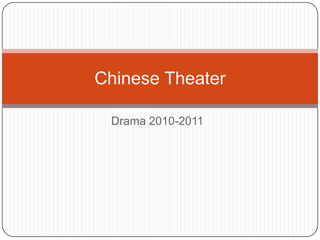
Chinese theater
- 1. Drama 2010-2011 Chinese Theater
- 3. Beginnings of Chinese Theater Since 100 BCE there has been some records of theatrical performance during the Shang Dynasty. These performances would include music, clowning, and acrobatic displays. Theater flourished in the Tang Dynasty, also known as “The Age of 1,000 Entertainments”. The first evidence of Chinese opera was created by Ming Huang who began the Pear Garden school whose theater was based primarily around music.
- 4. Shadow Plays
- 5. Shadow Play Shadow puppetry became famous during the Dynasty of Empress Ling There are two distinct forms of puppetry: Cantonese Pekingese The differences were the positioning and making of the puppets Both styles performed plays depicting great adventures and fantasy
- 6. Shadow Play continued… Cantonese shadow puppets were the largest of the two Pekingese puppets were smaller and more delicate. Puppets are painted with vibrant colors and cast a colorful shadow. After shows, the puppet’s head would be taken off so that it would not come alive. Shadow puppetry came to its height until it was sued for political purposes.
- 8. Chinese Opera During the Song Dynasty, there were many popular plays involving acrobatics and music. In the Yuan Dynasty this developed into a more sophisticated structure with a four or five act structure. Yuan drama spread across the country into various forms with Beijing Opera being the most famous form.
- 10. Beijing Opera continued… Beijing Opera combines music, vocal performances, mime, dance, and acrobats. Developed in the 18th Century and established in the 19th Century. Very popular in the Qing Dynasty court. Considered a cultural treasure of China. The performers are the focus and actors are judged by their graceful movements. Actors must adhere to specialized movements and conventions.
- 11. Beijing Opera Continued… There are over 1,400 works based on Chinese history, folklore, and now contemporary life. Beijing Opera was an exclusively male pursuit. During the 1870’s women began to appear unofficially. In 1911 females were officially allowed to perform, but for many years the all make company would be preferred. During the Communist take over, the Chinese Communist Party sought to bring art into line with Communist ideology.
- 12. Beijing Opera continued… Any performances without Communist themes were “subversive” and banned. Jiang Qing, Mao’s wife, chose eight model plays that could still be performed which included 5 Beijing Operas. These plays would be altered with their endings changed. As the Cultural Revolution (1966-1976) raged on, Beijing Opera would be banned and theaters shut down and destroyed.
- 13. Beijing Opera continued… The Republic of China in Taiwan took Beijing Opera as “political symbolism” in which the Kuomintang wanted Beijing Opera to take over other indigenous arts. The R.O.C. wanted to be the sole representative of Chinese culture. This occurred at the expense of Taiwanese opera, but currently, the interest in Taiwanese opera continues to grow.
- 14. Training in Beijing Opera Requires a long and arduous apprenticeship from an early age (usually a 7 year apprenticeship) The students would acquire debt to his master and repay him through performances. Students would rise at 5:00 in the morning for exercise IN the daytime for acting and combat At night they performed in outdoor theaters. If mistakes were made each member of the company would be beaten.
- 15. The Roles in Beijing Opera Sheng
- 16. The Roles in Beijing Opera Dan
- 17. The Roles in Beijing Opera Jing
- 18. The Roles in Beijing Opera Chou
